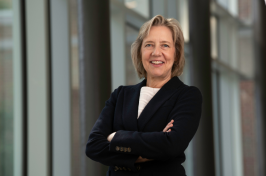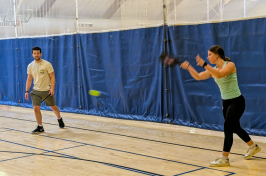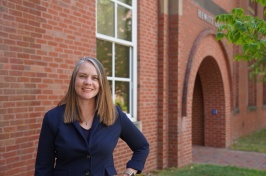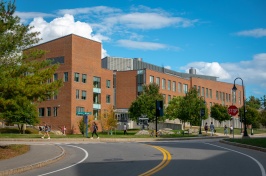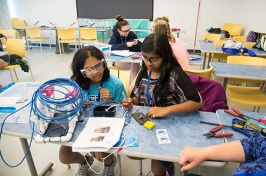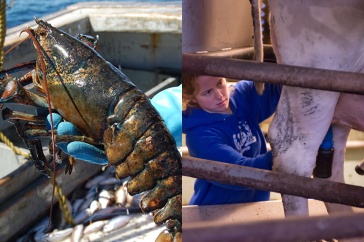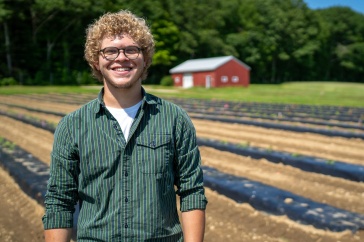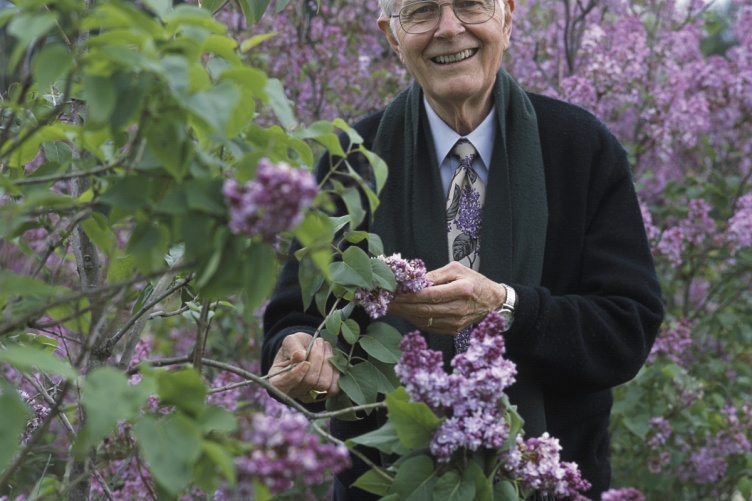
The University of New Hampshire mourns the loss of Owen Maurice Rogers, 85, professor emeritus of plant biology in the College of Life Sciences and Agriculture, who passed away Tuesday, May 24, 2016. Rogers devoted his career to breeding lilacs, the New Hampshire state flower, and was instrumental in developing UNH’s lilac breeding program that spanned 60 years, the longest continuous lilac breeding program in the United States.
“How could you not be enamored by the lilac? The virtues that it has, there are many. Between the variation in size of plants and colors of plants, the lilac fills all the bills. The fragrance is very nice. You can hardly go wrong with the lilac,” Rogers said in a short documentary “For the Love of Lilacs” produced by the Wentworth-Coolidge Commission.
Nationally Known Lilac Expert
Known nationally for his lilac expertise, Rogers conducted much of his research at the UNH Woodman Horticultural Research Farm, a facility of the NH Agricultural Experiment Station, which supported Rogers’ lifetime of research. Recalling his early mornings among the lilacs at Woodman Farm, Rogers remembered standing alone, gazing at a brand new cultivar, a flower no one else on earth has ever seen before. "Now that," Rogers told the UNH Magazine in 2007, "that is really worth something."
Rogers was among UNH’s lilac breeders who solidified UNH’s place as the center of lilac breeding for six decades beginning in the 1940s. UNH scientists with the New Hampshire Agricultural Experiment Station developed 10 varieties of lilacs. The three principal UNH scientists engaged in this work were Elwyn Meader, Albert Yeager, and Rogers. The experiment station’s Woodman Horticultural Research Farm still exhibits the fruits of this lilac research with many varieties blooming every year. In addition, lilacs developed at UNH can be seen behind Thompson Hall on campus and in the faculty neighborhood. Rogers retired from UNH in 1996.
“The primary work being done with lilacs at UNH is to develop species that will extend the bloom season. Our accent is on breeding better lilacs, which will come into bloom after the common lilac has peaked and faded,” Rogers told the New York Times in 1979.

Rogers cross-bred thousands of varieties of lilacs and introduced three new lilacs. The Agnes Smith Lilac is a white lilac Rogers introduced in 1970. It is named for Agnes Greene Smith of Portsmouth, the first president of the New Hampshire Federation of Garden Clubs. It was marketed in Germany as the Miss USA. The Agnes Smith was chosen as the best plant introduction of 1973 by the International Propagators Society and is considered one of the finest white lilacs in the world. The Jesse Hepler Lilac is a purple lilac Rogers introduced in 1981. It is named for Jesse Hepler, UNH professor emeritus of horticulture.
The Marie Rogers Lilac is a light violet lilac introduced in 2003 by Rogers and Walter Oakes of Dixfield, ME. This lilac was named by Walter Oakes for Owen’s wife Marie Rogers. Marie met Owen while they were both in the U.S. Air Force, where she worked as a recruiter. In 1951, Marie was stationed in Rochester, NY, home of the Rochester Parks Lilac Collection. Oakes was a founding member of the International Lilac Society and selected the plant from a batch of open pollinated seedlings received from Rogers in 1992.
“Jesse Hepler has been introduced but not widely propagated or marketed. It is important because it is the latest blooming lilac in New England, and possibly the world. No other lilac is known to bloom as late, which extends the lilac bloom time by several weeks,” said John Bentley, author of Lilacs: A New Hampshire Perspective.
Rogers was an active member of the International Lilac Society, serving s president, editor, and in other capacities. He is the recipient of the Director’s Award (1979), the Honors and Achievement Award (1984), the Arch McKean Award (1991), and the Distinguished Recognition Award (2001) of the International Lilac Society. He also served as a commissioner on the NH Governor’s Lilac and Wildflower Commission.
In addition to his lilac breeding work, Rogers taught classes in plant genetics and breeding at UNH, judged flower shows, and served in the U.S. Air Force Reserve for 20 years. He was considered the unofficial spokesman for lilacs in New Hampshire, appearing in magazine articles and on television to promote lilacs well into his retirement.
Birth of the First Lilac Register
While on sabbatical in 1975, Rogers compiled the Tentative International Register of Cultivar Names in the Genus Syringa L., a lilac register patterned after Lilacs for America (1953). Published by the NH Agricultural Experiment Station in 1976, it became the cornerstone of the International Register and Checklist of Cultivar Names of the Genus Syringa L. (2007).
“The success of the Tentative registry eventually led to it becoming the registry of lilacs. Thus, anybody who wanted to announce a new lilac had to go through UNH. This encouraged much interchange of information about lilacs with the UNH staff, who in turn connected to a larger network worldwide,” said Bradley Bittorf, executive vice president of the International Lilac Society.

Freek Vrugtman, curator emeritus of the Royal Botanical Gardens, Ontario, Canada, and International Lilac Registrar for the Royal Botanical Gardens, now manages the registry of lilacs. He first met Rogers in the early 1970s at an annual convention of the International Lilac Society.
“When in late 1974 I was asked to take on the international registration of cultivar names of lilacs, Owen encouraged me to accept. Not only that, Owen also dedicated his sabbatical leave to creating a card index of all lilac cultivar names he could find in the available horticultural literature–this was the pre-computer and pre-internet era! His findings were summarized in the “Tentative International Register of Cultivar Names in the Genus Syringa,” NH Agricultural Experiment Station Research Report No. 49; April 1976. At the top of the first page of the copy Owen sent me he had written, ‘This is where your troubles begin,’” Vrugtman said.
“The box of index cards and the Tentative Register gave me the tools for a head start and provided the pattern I followed for about two decades. Consultations would go both ways; Owen was a horticultural geneticist, I a horticultural taxonomist. Owen was interested in lilac genetics and in finding or predicting the genetic combinations that would give the best results in hybridizing. I was interested in obtaining good descriptions of new cultivars and being able to classify them according to their genetic background. Having access to the University of New Hampshire library, Owen was always helpful in locating literature references I may be looking for,” he said.
Following his retirement, Rogers sorted his lilac papers and correspondence, and Vrugtman said from time to time, he would receive envelopes or parcels with a wide variety of papers. “Owen knew the value of personal letters and notes that were relevant to the history of the garden lilac. Notes that have found their way into files that may be of interest to future researchers and writers.”
“Owen’s values, his knowledge, and ideas have been passed on to the younger generations. I was lucky to get to know him and work with him,” he said.
Colleagues Share Memories
Janet Sullivan, adjunct associate professor of biological sciences and collections manager of the Hodgdon Herbarium, shared an office with Rogers after the department moved to Spaulding Hall from Nesmith Hall in 1996.
“He was a very gregarious person, and he loved UNH. He felt he had been blessed in life as far as his academic career and opportunities. He loved his family, and was especially happy to be able to spend time with his grandson. He fully enjoyed his retirement, doing the things he loved: sharing his knowledge and love of plants (especially lilacs), socializing and keeping everyone connected, and traveling. He was generous with stories and advice,” Sullivan said.
Sullivan said Rogers’s appointment as editor of the Lilac Journal enabled him to stay connected to his colleagues in the International Lilac Society in a meaningful way after retirement. He kept current with nomenclature, new cultivars, research, and looked forward to the annual meetings.
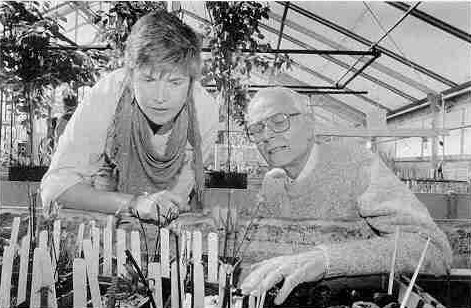
Rogers also loved being involved with Elderhostel and Interhostel. “It gave him the chance to travel and to talk to people. Every fall for a few years after retirement he went on a fall foliage bus trip up into the White Mountains, where they had him ride at the front of the bus with a microphone -- a captive audience and a free meal! I still circulate in class each year a piece of bark from a cork oak that he brought back for me from the Mediterranean,” Sullivan said.
Staying in contact with former and current colleagues was important to Rogers, who organized monthly coffee socials for the Department of Plant Biology. “He organized these gatherings with a lot of enthusiasm; he would call all the retired members of the department and invite them to attend (and enjoyed the chance to chat with each on the phone). He loved the chance to connect with everyone, and to get everyone together so that we could all interact in an informal way. He also loved organizing the annual Holiday Greens Party. This was another opportunity to bring members of the department together to socialize,” Sullivan said.
“Professionally, his work was well respected. Folks would call the office frequently to ask about his plantings out at the farm. I think he was especially proud of the 'Marie Rogers' lilac cultivar he created and named for his wife. He retained his curiosity and love of ornamentals throughout his retirement; he made routine tours of campus to check out new plantings or to report on what was in bloom. If he found something new he'd come back to the office to confirm his ID and look up the details in Dirr's Manual of Woody Landscape Plants,” she said.
Barb Rollins, landscape specialist supervisor with the NH Department of Transportation, worked with Rogers for many years on the NH Governor’s Lilac and Wildflower Commission. “He was a true delight to work with, a gentleman, and his wit was always a welcome! He was also a judge for the many entries in the annual Lilac Photo Contest held in August, something he enjoyed and took pride in. I feel privileged to have known and worked with Owen and will miss him very much,” Rollins said.
Art Mathieson, professor of plant biology at UNH, said Rogers “was always outgoing and very friendly. In particular, he made special efforts to enhance social interactions within the Plant Biology Department, often hosting teas and special activities. He was a very kind and thoughtful man and always helped with various projects and activities. I miss his wonderful smile and interactions.”
Jim Stewart, professor emeritus of biochemistry at UNH, said Rogers was a “genuinely enthusiastic teacher. He brought his sense of humor, always gracious but sometime edgy, into the classroom. Students always paid rapt attention and actually enjoyed his classes.”
“One thought always came to the forefront was his research for many years with breeding lilacs suitable to New Hampshire and his promotion of lilacs throughout the state. He was a patient man since it could take 10 years to develop a new lilac variety. Over the years he introduced new varieties, one even named after his wife, Marie,” Stewart said. “After retirement Owen stayed active in some aspects of the Plant Biology Department. He even originated, organized, and prepared a coffee break meeting for faculty, staff, and students centered on a new dessert each month.”
Bittorf, of the International Lilac Society, recalls one of his first memories of learning about the academics of lilacs at a hotel in Clinton, Iowa, where the society was meeting. Ed Hasselkus, now professor emeritus at the University of Wisconsin who also did much work in lilacs, and Rogers “were exchanging stories about plant biology, tree bark habits, and so on at a poolside table over drinks. Somehow, they had received an extra drink at their table, and they invited me to sit down, enjoy the drink, and hear the science and the stories. I often say this was the start of my ‘absorption of information by osmosis’ about lilacs. I was honored to share time with these two prominent professors.”
Community Service Planned
Rogers was born on July 4, 1930, in Worcester, Mass. He received his bachelor’s degree in 1952 from the Massachusetts Agricultural College, now the University of Massachusetts-Amherst; his master’s degree in 1954 from Cornell University; and his Ph.D. in 1959 from Pennsylvania State University. He was a Master Mason.
He is survived by his wife Marie Rogers of Durham; two daughters, Mary Rogers LaPolice and her husband Matthew LaPolice of Durham, and Lucy Parkman of Dover; and a grandson, Troy LaPolice of Durham. Funeral services for Rogers are private. A community celebration of his life is planned for a later date at the Durham Community Church.
-
Written By:
Lori Tyler Gula, PhD | NH Agricultural Experiment Station | lori.gula@unh.edu | 603-862-1452












